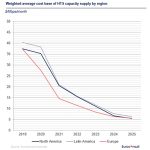According to the research, 43m people were connected to broadband via satellite, and this number is expected to grow to 110m in 2029.
 The global market for satellite broadband is expected to triple with service revenues reaching $12.7bn by 2029, according to a report on Universal Broadband Access by Euroconsult, an independent consulting and analyst firm specialised in satellite-enabled vertical markets.
The global market for satellite broadband is expected to triple with service revenues reaching $12.7bn by 2029, according to a report on Universal Broadband Access by Euroconsult, an independent consulting and analyst firm specialised in satellite-enabled vertical markets.
The Euroconsult research found that in 2020, 43m people were connected to broadband via satellite, roughly 1% of the worlds connected population. This number is expected to grow to 110m in 2029, with Latin America adding roughly 20m users and Sub-Saharan Africa adding 16m.
With 46% of the worlds population still unconnected, satellite broadband remains key to bringing essential services to sparsely populated regions where extending terrestrial networks is not economically feasible.
Significant progress has been made to expand access and adoption of broadband services as demonstrated by the growth in internet users, which doubled between 2010 and 2020, to just over 4bn users worldwide in 2020. The Covid-19 crisis has highlighted the importance of universal broadband access and accelerated efforts towards bridging the divide between those with high-speed broadband access and those without connectivity.
Dimitri Buchs, Senior Consultant at Euroconsult, said: Organisations such as the Broadband Commission for Sustainable Development set targets to encourage governments to invest in programmes that contribute to bridging the digital divide. Overall, the broadband ecosystem will be central to building the post-Covid-19 world, notably by making sure universal equitable access to broadband services is part of the new normal. We have a long way to go to achieve this, but satellite will be key to reaching many who are currently unserved or underserved.
There are three categories of satellite solutions that address the Universal Broadband market. They include consumer broadband, Wi-Fi hotspots, and cellular backhaul. Consumer broadband is currently the dominant option in advanced economies while Wi-Fi hotspots are most frequently used in less developed regions, notably due to the lower cost of services and the ability to share costs among a large number of users.

















































































